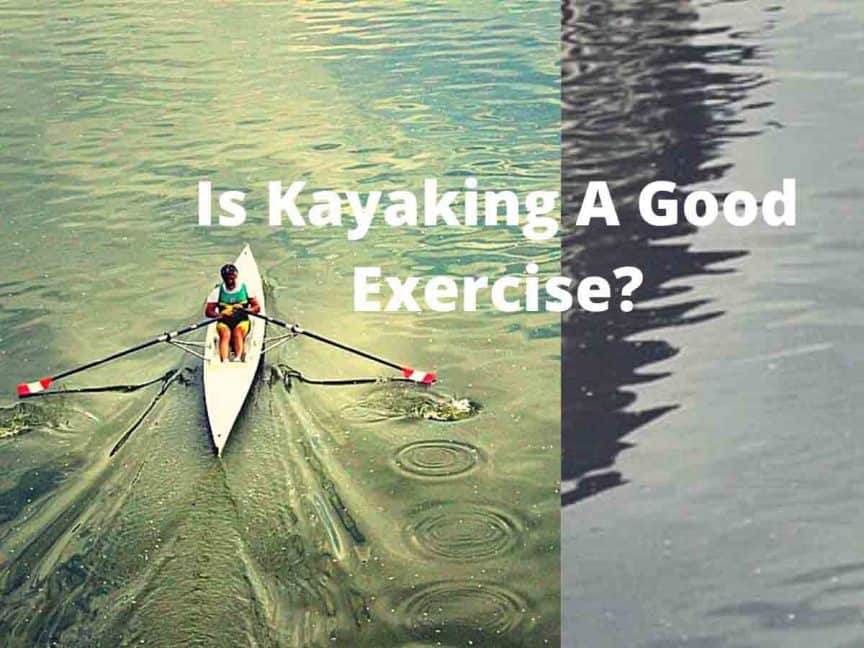If you are thinking of a way to keep fit and have fun then you should consider kayaking. Kayaking is one of the best outdoor activities that puts you right in the middle of nature and provides a great workout. When you go kayaking, you will not only build lean muscles but also burn fat. The question that you are probably asking yourself is kayaking good exercise? Yes, kayaking is a good exercise.

Is Kayaking Good Exercise
Because kayaking engages your arms, it can be a good exercise for strengthening your arms and forearms. The controlled upper body twist that comes with kayaking can help enhance your core strength. Additionally, kayaking is one of the best ways to build your back, shoulders, and chest muscles. Most people can go kayaking without requiring special training or skill, which makes it a great sporting activity for the entire family.
Physical benefits of kayaking
Reduced stress It goes without saying that exercise plays an important role in reducing stress. The good thing about kayaking is that it benefits users in more than one way because the kayak not only works your muscles as you paddle but also helps you relax as you paddle in open water.
If you are stressed out, you can kayak in a calm lake and enjoy the relaxing sound of the water and enjoy the fresh air as well as the natural environment.
Weight loss
If you want to lose weight, you need to burn more calories than you consume. Adding exercise routines such as kayaking is a key factor that helps in weight loss.
To move at a speed of 5 mph you are going to require approximately 0.1 hp of effort which burns about 400 calories per hour. So, if you kayak for 4 hours you are going to burn about 1600 calories.

Health Benefits Of Kayaking
Enhanced heart health
Kayaking can help raise your heart rate, which produces a wide variety of cardiovascular health benefits with time. When you are kayaking at a high level, you will not only burn more calories but also improve your blood pressure.
Additionally, your good cholesterol will go up while the bad cholesterol down, which makes it less likely to develop medical conditions such as diabetes or heart disease.
Flattens your tummy
Kayaking can help tone and flatten your tummy. If you want to glide over open water, you will need to paddle the kayak which takes lots of core movement and strength. Paddling the kayak with the 1-piece paddle on both sides requires twisting that targets muscles which might be overlooked by other workouts.
It strengthens your lats
If you want to be stronger, you need to work out your muscles. The muscle groups which benefit the most from kayaking are lats or lower back muscles.
With every stroke you make on a kayak, your lats are heavily exercised. If you want to work out your lats more you should consider varying the rowing speed. You can choose rowing at a fast speed for a short time or do it more slowly.
Great source of Vitamin D
Vitamin D is one of the essential nutrients required in the body so that at to function optimally. In case your body lacks Vitamin D, your bones might become brittle and break easily.
The good thing about kayaking is that it gives you the opportunity to soak up the sun and get the vital Vitamin D. Kayaking for only 15 minutes in sunny areas can trigger Vitamin D production.
Mental benefits of kayaking
Exercising regularly has been proven to eradicate symptoms of mental health such as depression and anxiety. When you are physically active, it will increase blood flow to your brain and stimulate good hormones such as serotonin, endorphins, and dopamine.
Reports show that kayaking has a positive effect on mental health. Other studies have shown that aerobic exercises like kayaking can release chemicals into the body which can lift your mood, and provide a sense of well-being.
One of the benefits of kayaking is that it contributes to mental clarity. This means that your brain is calm even when you experience the beauty of nature while on open water.
The other mental benefit of kayaking is that it makes you happier. When you combine time spent outdoors as well as physical exercise, it is known that it can lead to happiness.
Additionally, kayaking can help reduce your stress levels. Therefore, if you are suffering from mental health problems like depression, you should consider engaging in a sporting activity like kayaking. Kayaks and canoes are different, but all these mental benefits can also be achieved by canoeing.
For more benefits, you can practice a few minutes of meditation and deep breathing while you are kayaking.
The social side of kayaking
Although a kayak is designed to be used by one person at a time, you should not kayak alone. Kayaking is a social activity that can be done with a team of kayakers.
For example, you can choose to paddle with family and friends. The benefit of this is that if you get into trouble, you will have someone to help you. As a beginner, you may find it difficult to kayak with other people but with time it will change. When you join a kayaking club, you will get the opportunity to bond and make new friends.
Is kayaking a good way to lose weight?
If you have been trying to lose weight, then you will not go wrong with kayaking. But for kayaking to be considered as an effective weight loss workout it needs to effective at burning calories.
For you to see results, you need to exercise as often as you want. Kayaking for 1 hour via the waters can help you burn 400 calories. That means, if you spend 3 hours kayaking on the waters, it can burn up to 1200 calories.
This is why kayaking is considered to be one of the top workouts for those who want to burn more calories in conventional weight loss such as jogging.
What muscles does kayaking exercise?
The first muscle group that kayaking targets are the ones available around your arms. The biceps and triceps are the muscles that help you paddle through the water. These muscle groups work in conjunction with the upper back to propel you forward.
The second muscle groups that are worked out are the ones in your hands and forearms. You will need a tight grip to hold on to a paddle and apply constant tension to your hands and fingers.
Third, you will work out the muscles available on your shoulders. After every pull, you will need to bring back the paddle which exercises the anterior, lateral, and rear deltoids of your shoulder.
The fourth muscle groups which are exercised while stroking a kayak are the ones in your oblique, lower back, and abdomen.
Fifth kayaking targets your lower body muscles which include muscles in your quadriceps, hamstrings, glutes, and calves while you are on the water.
Is kayaking better cardio or strength?
Kayaking is a great strength workout because it strengthens your arms, shoulders, and lower body. As you push the paddle and twist your upper body, you are working out your shoulders, back, and chest.
Additionally, kayaking helps improve lower body strength and increase muscle strength. Kayaking might be good for strength but it offers more benefits when used as an aerobic exercise.
For you to enjoy a good cardio work out, you need to increase the pace and elevate your heart rate. This means you can burn between 400 and 500 calories in 1 hour of kayaking making it an effective cardio exercise just like using a treadmill or elliptical.
Is kayaking good for your back?
The answer to the question is kayaking a beneficial exercise for your back is yes. Paddling, balancing, and controlling a kayak can help strengthen your back muscles as well as lower back and spine muscles.
Make sure you use good posture and twisting motions as you paddle the kayak. With time, you will have a stronger back which is less prone to pain.
Is it easy to kayak?
Kayaking is a wonderful sport that can be learned by any beginner. Just like cycling, it is very simple to pick up the art of kayaking. Within a few hours of practicing, you will paddle along happily. Note that for you to do kayaking, you will need to work out your body.
Never forget to warm up before kayaking and start with mental and physical preparation for kayaking.
Disadvantages of kayaking
Sun exposure
One of the disadvantages of kayaking is that it leads to sun exposure. Kayaking for one hour might be dangerous but if you kayak for longer it can be a big threat. This may lead to health conditions such as heat stroke, heat exhaustion, sunburn, and dehydration. To protect yourself from the sun, it is advisable that you wear sunscreen or a hat.
Dehydration
When you are exposed to too much sun while kayaking, it can lead to dehydration. Signs of dehydration include confusion, dizziness, fatigue, and extreme thirst, which can adversely affect your ability to paddle a kayak.
Also, kayaking requires a lot of energy which is why you need to stay hydrated. Depending on how hot it is outdoors, you need to carry enough bottles of water.
Hypothermia
Hypothermia can occur when a kayaker is exposed to cold temperatures for extended time periods. This can happen if someone is submerged in cold water but can happen if you are badly dressed and paddling in cold air.
Conclusion
By now you know the answer to the question is kayaking good exercise. Kayaking is a wonderful exercise that strengthens your shoulder muscles, glutes, and core. As you move the paddle, you are strengthening the muscles in your arms, shoulders, back, and chest.
Also, kayaking can lead to increased leg and torso strength as you power the kayak and rotate the torso, which applies pressure to your legs. Kayaking can give you a good cardio workout as you paddle the kayak through the waters.



